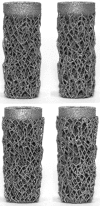Additive manufactured push-fit implant fixation with screw-strength pull out
- PMID: 29023901
- PMCID: PMC6175131
- DOI: 10.1002/jor.23771
Additive manufactured push-fit implant fixation with screw-strength pull out
Abstract
Additive manufacturing offers exciting new possibilities for improving long-term metallic implant fixation in bone through enabling open porous structures for bony ingrowth. The aim of this research was to investigate how the technology could also improve initial fixation, a precursor to successful long-term fixation. A new barbed fixation mechanism, relying on flexible struts was proposed and manufactured as a push-fit peg. The technology was optimized using a synthetic bone model and compared with conventional press-fit peg controls tested over a range of interference fits. Optimum designs, achieving maximum pull-out force, were subsequently tested in a cadaveric femoral condyle model. The barbed fixation surface provided more than double the pull-out force for less than a third of the insertion force compared to the best performing conventional press-fit peg (p < 0.001). Indeed, it provided screw-strength pull out from a push-fit device (1,124 ± 146 N). This step change in implant fixation potential offers new capabilities for low profile, minimally invasive implant design, while providing new options to simplify surgery, allowing for one-piece push-fit components with high levels of initial stability. © 2017 The Authors. Journal of Orthopaedic Research® Published by Wiley Periodicals, Inc. on behalf of the Orthopaedic Research Society. J Orthop Res 36:1508-1518, 2018.
Keywords: 3D printing; initial implant stability; minimally invasive implants; porous implants; press-fit.
© 2017 The Authors. Journal of Orthopaedic Research® Published by Wiley Periodicals, Inc. on behalf of the Orthopaedic Research Society.
Figures












Similar articles
-
Stability of small pegs for cementless implant fixation.J Orthop Res. 2017 Dec;35(12):2765-2772. doi: 10.1002/jor.23572. Epub 2017 May 23. J Orthop Res. 2017. PMID: 28387966 Free PMC article.
-
Influence of cement compressive strength and porosity on augmentation performance in a model of orthopedic screw pull-out.J Mech Behav Biomed Mater. 2018 Jan;77:624-633. doi: 10.1016/j.jmbbm.2017.10.016. Epub 2017 Oct 13. J Mech Behav Biomed Mater. 2018. PMID: 29100205
-
Influence of trabecular bone quality and implantation direction on press-fit mechanics.J Orthop Res. 2017 Feb;35(2):224-233. doi: 10.1002/jor.23257. Epub 2016 Apr 18. J Orthop Res. 2017. PMID: 27061728
-
Fabrication methods of porous metals for use in orthopaedic applications.Biomaterials. 2006 May;27(13):2651-70. doi: 10.1016/j.biomaterials.2005.12.002. Epub 2006 Jan 19. Biomaterials. 2006. PMID: 16423390 Review.
-
Material properties and composition of soft-tissue fixation.Arthroscopy. 2010 Jun;26(6):821-31. doi: 10.1016/j.arthro.2009.12.026. Arthroscopy. 2010. PMID: 20511042 Review.
Cited by
-
Impaction technique influences implant stability in low-density bone model.Bone Joint Res. 2020 Jul 31;9(7):386-393. doi: 10.1302/2046-3758.97.BJR-2019-0303.R1. eCollection 2020 Jul. Bone Joint Res. 2020. PMID: 32793333 Free PMC article.
-
Auxetic Biomedical Metamaterials for Orthopedic Surgery Applications: A Comprehensive Review.Orthop Surg. 2024 Aug;16(8):1801-1815. doi: 10.1111/os.14142. Epub 2024 Jul 3. Orthop Surg. 2024. PMID: 38961661 Free PMC article. Review.
-
Bioreactor analyses of tissue ingrowth, ongrowth and remodelling around implants: An alternative to live animal testing.Front Bioeng Biotechnol. 2023 Feb 20;11:1054391. doi: 10.3389/fbioe.2023.1054391. eCollection 2023. Front Bioeng Biotechnol. 2023. PMID: 36890911 Free PMC article.
-
Increasing reaming depth enhances implant stability while minimizing bone strain.Bone Joint Res. 2025 Jun 19;14(6):551-559. doi: 10.1302/2046-3758.146.BJR-2024-0118.R3. Bone Joint Res. 2025. PMID: 40533079 Free PMC article.
-
The limit of tolerable micromotion for implant osseointegration: a systematic review.Sci Rep. 2021 May 24;11(1):10797. doi: 10.1038/s41598-021-90142-5. Sci Rep. 2021. PMID: 34031476 Free PMC article.
References
-
- Mall NA, Chalmers PN, Moric M, et al. 2014. Incidence and trends of anterior cruciate ligament reconstruction in the United States. Am J Sports Med 42:2363–2370. - PubMed
-
- National Joint Registry for England and Wales. 2016. 13th Annual Report.
-
- New Zeland Joint Registry. 2016. 17th Annual Report.
-
- Chapman JR, Harrington RM, Lee KM, et al. 1996. Factors affecting the pullout strength of cancellous bone screws. J Biomech Eng 118:391–398. - PubMed
Publication types
MeSH terms
LinkOut - more resources
Full Text Sources
Other Literature Sources

